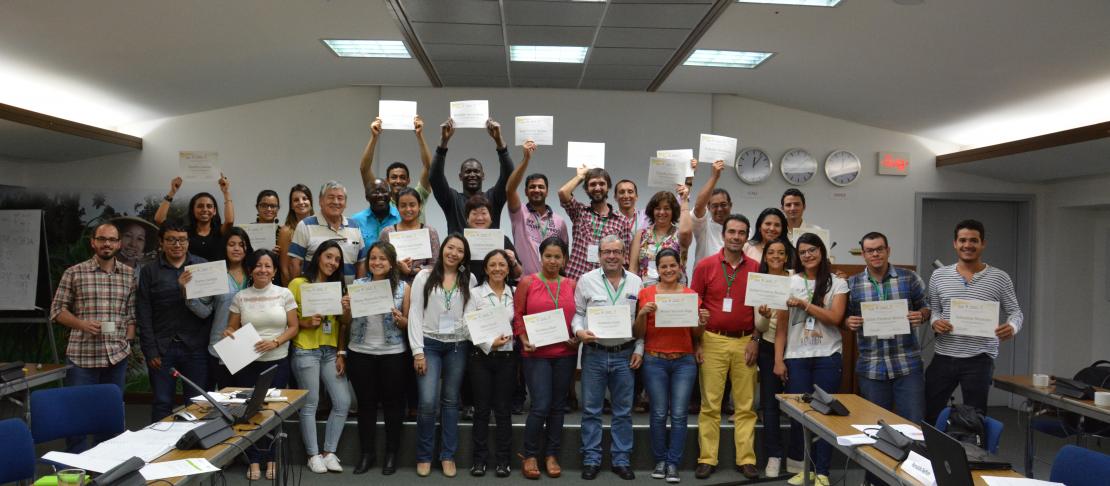Climate change, production systems and soil issues addressed in a unusual summer school

PhD students from Brazil, Nicaragua, Trinidad and Tobago, and Colombia participated in the intensive course in climate change mitigation: innovation measurements, models and policies, held at CIAT headquarters.
The course, called informally a summer school, was organized by the CGIAR Research Program on Climate Change, Agriculture and Food Security (CCAFS) and the International Center for Tropical Agriculture (CIAT), with the goal to ensure that participants understand the process responsible for the production and emission of greenhouse gases (GHGs) in agricultural systems; to learn about the approaches used to quantify gas emissions in agricultural systems; to understand the application of different models and tools for amplification of GHGs; and to obtain a better understanding in the design and contribution of low emission development strategies.
It is usually difficult to make friends in the scientific field, but here was different. We had the opportunity to work in an environment where the joy is contagious,"
said Eztequiel Martin, a doctoral student at the University of Cordoba in Argentina.
Five days of mutual learning
This unusual summer school with a friendly atmosphere was dedicated to topics such as agriculture seen as source and sink of GHG, tools to estimate emissions, and strategies for mitigation. Each one of the five days were full of insights and lessons to keep in mind. For instance:
- It is highly recommended to find a breakeven in productive systems such as livestock through comprehensive approaches as LivestockPlus, which not only is about livestock production, but also about making this a sustainable activity in terms of the use of natural resources such as soil and the adoption of climate-smart practices like silvopastoral systems.
- The field practices made by participants with urine patches in cattle and the use of static closed chamber, allowed them to analyze the tradeoffs of different approaches for quantifying GHG, becoming clear for everyone that the decision of which approach should be used depends on the goal of the study to be performed.
- The economic development must be closely linked with a strategy for climate change mitigation, emphasizing the reduction of GHG emissions and the reduction of water and carbon footprint of different production systems.
In the words of Laura Arenas, a young researcher of the Soils Research Area at CIAT, the course can be described as "a space to learn from each other, receive feedback, strengthen knowledge and meet colleagues with whom it is expected to work over the next years."
There were also opportunities to interact with government institutions such as the Colombian Corporation for Agricultural Research (Corpoica), the Institute of Hydrology, Meteorology and Environmental Studies of Colombia (IDEAM), the Ministry of Agriculture and Rural Development (MADR) and the Ministry of Environment and Sustainable Development (MADS) of Colombia; and the Ministry of Agriculture and Livestock of Costa Rica (MAG). There were also participants from private sector like the Federation of Rice Producers (Fedearroz), the Center for Research on Sustainable Agricultural Production Systems (CIPAV) and academia, represented by the National University and the University of Antioquia, from Colombia.
R Belfon, PhD student at the University of West Indies, in Trinidad and Tobago, said: "We not only talked about science, we had a very valuable interaction between a diversity of stakeholders in order to make science have an impact on society".
Belton and his colleagues are now back in their respective countries where each one of them will conduct an experiment. They will meet again to continue strenghtening their capacities through the exchange of knowledge.
This is just the beginning
The participation of these young researchers in this intensive course is the first of the promising results that already started, thanks to the call launched months ago by the recently created Latin American Research Network and Mitigation of Greenhouse Gases (LAMNET) under the Climate Network of Food and Agriculture (CLIFF), an initiative arising from the collaboration between CCAFS and CIAT, to encourage individual and institutional capacity to monitor emissions of greenhouse gases in different agro-ecosystems.
This text was originally published in Spanish on the CIAT soils blog. View the original.



